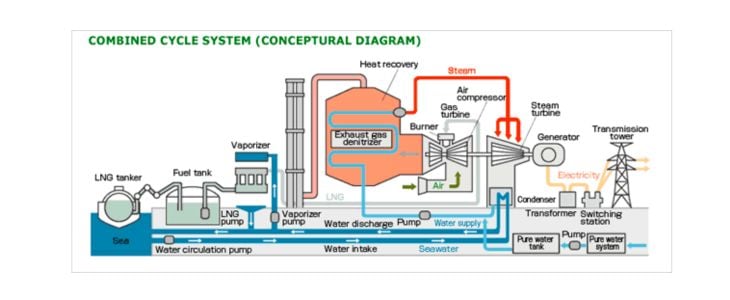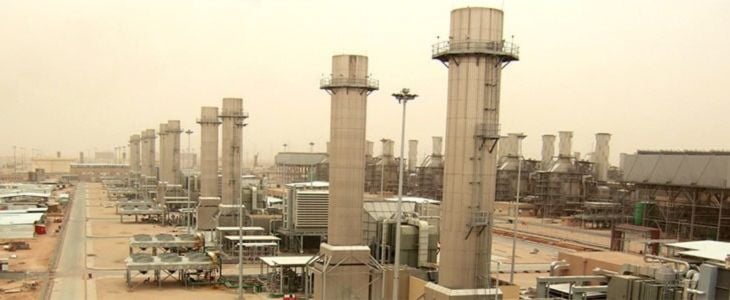As the energy demand continues growing at a global level, achieving combined cycle power plant efficiency stands out as an increasingly relevant solution to enhance energy production.
Paying attention to CCGT efficiency not only brings about a number of economical advantages, but also enhances the sustainability of power production. Find out what leading companies and thermal engineers are doing to achieve combined cycle power plant efficiency.
The combined cycle power plant: why it’s crucial for the energy generation of the future
A combined cycle power plant is a type of power plant that uses a gas turbine cycle and a steam turbine cycle in a sequential manner to generate electricity efficiently.
As such, both cycles collaborate to transform heat energy into mechanical energy: the exhaust gasses produced by a gas turbine are used to produce steam, thus extra power is generated without the need for further energy inputs. Broadly speaking, one third of the power output of a combined cycle power plant comes from the steam turbine cycle, with the other portion being produced by the gas turbine cycle.
The reason behind the recent prominence of this energy production method is its enhanced efficiency: because two (or more) thermodynamic cycles are combined, overall efficiency is increased, as well as fuel costs lowered. In fact, producing energy from different workstreams has meant efficiencies of between 50% and 60% can be achieved. This makes combined cycle power plants a more environmentally-friendly option for power generation compared to other conventional alternatives. In fact, the U.S. Energy Information Administration lists the CCGT as the most efficient power plant type.
How does a combined cycle power plant work
- Gas turbine cycle: in the initial stage, heat must be obtained. Commonly, these systems burn natural gas or another type of fuel in a gas turbine, driving a generator to produce electricity. This process generates exhaust gasses from the gas turbine (typically around 1,000°C), which contain a significant amount of energy.
- Waste heat recovery: the hot exhaust gasses don’t go to waste, but are used to generate steam in a heat recovery steam generator (HRSG). The result is high-pressure steam.
- Steam turbine cycle: this high-pressure steam is used to drive a steam turbine, which also drives a generator and, as a result, additional electricity is produced.
The result is a combined power output that allows the plant to generate more electricity from the same amount of fuel compared to a single-cycle power plant.
While this is in itself a great enhancement in combined cycle power plant efficiency, operators are looking for ways to optimize it and gain a competitive advantage, as well as improve their sustainability.
How to achieve combined cycle power plant efficiency
As we’ve seen above, combined cycle power plants are known for their high thermal efficiency, typically reaching over 50% and sometimes above 60%. In other words, they’re able to produce more electric energy compared to the fuel used. In fact, the Guinness World Records includes a combined cycle power plant that, in 2016, became the most efficient at the time, with a percentage of 62.22%.

However, the race for optimizing combined cycle power plant efficiency has only started. In this quest, there are several paths that are being experimented with, and one of the most promising looks precisely at what was considered the biggest drawbacks of combined cycle power plants: their reduced performance during high ambient temperature periods.
Combined cycle power plant efficiency depends on ambient air temperatures: the higher they are, the lower the efficiency. This is because gas turbines “breath in” air to send to the compressor: the air’s mass flow and density are strongly affected by warm temperatures and, as a consequence, so is the turbine’s efficiency.
This is particularly worrying because electrical peak demand periods are usually coincident with high ambient temperature periods (for instance, when cooling is needed during summer).
This is where Turbine Inlet Air Cooling Systems come in. These can be defined as the group of technologies that are employed to cool down the intake air of the Gas Turbine (GT) with the ultimate goal of power output augmentation.
While the standard ambient conditions for a gas turbine are 15˚C and 1.013bar, TIAC systems work to ensure these conditions are met so that turbines can perform optimally throughout the year. The result is the turbine accessing constant inlet air temperature, which in turn increases its power output and maintains its stability against temperature changes.
TIAC systems are in fact able to increase the gas turbine power output in percentages that range between 20 to 30%, while also increasing the exhaust flow. Additionally, the steam turbine power is increased between 2 - 5%
- Gas Turbine Power increase: 20 – 30%
- Steam Turbine Power Increase: 2 – 5 %
How does Turbine Inlet Air Cooling work?
Briefly speaking, TIAC systems aim to mimic cold ambient conditions for gas turbines. In order to do so, they employ a series of technologies:
- Fogging: in charge of reducing the inlet air temperature by evaporating a spray of water that gets activated after the filter stage.
- Evaporative cooler: includes the generation of a wet, porous surface where water is distributed and through which air passes
Chillers: compression chillers, absorption and engine-driven chillers are all used by TIAC technologies to reduce air temperatures as well as the air enthalpy.

Additionally, TIAC systems work following these working principles, among others:
- They can be set up for a turbine or a group of turbines which are set to operate for a limited period of the year to cover peak demand
- The most common method is evaporative cooling, that is, employing a liquid (typically water) to absorb heat and evaporate into vapor, an operation which reduces the temperature of the remaining liquid and the surrounding environment. However, this is not always the most optimal solution (for instance, in places where water scarcity is an issue). In these cases, there are other advanced power technologies that use refrigeration systems.
- Combined cycle power plant efficiency can be further optimized by TIAC systems that employ thermal energy storage (TES) to minimize operation time. This introduces waste heat recovery, guaranteeing there is minimal exhaust waste. Thermal energy storage (which works with different configurations, including ice-based or cold water storage systems, among others) comprises the technologies able to store excess cooling capacity during off-peak hours. This stored cooling energy can then be used during peak hours when demand is high, but the system is not able to generate enough energy. If combined cycle power plant efficiency was already high thanks to the use of exhaust gasses that would otherwise go to waste, TES technologies allows for an even better utilization of waste heat that allows it to meet demand.
While these are general efficiency rules, the incorporation of any TIAC system to enhance combined cycle power plant efficiency must look at each project’s needs and requirements. At ARANER, we work to devise new and retrofit projects that consider each location’s needs: there’s not a single or standard power augmentation solution, which is why at ARANER we adopt a customized approach for each project.
We have worked in challenging environments, such as plants in Saudi Arabia and Qatar, as well as worked to facilitate power recovery for plants during summer periods to avoid reductions in power generation during peak power demand periods. This is particularly crucial at a time when, on the one hand, longer and more intense heat waves are expected; while energy demand continues rising.
The introduction of TIAC and TES technologies to ensure combined cycle power plant efficiency thus stands out as an essential intervention in the current context.
Find out more about how TIAC can enhance your combined cycle power plant efficiency by getting in touch with us and speaking directly to our team.










